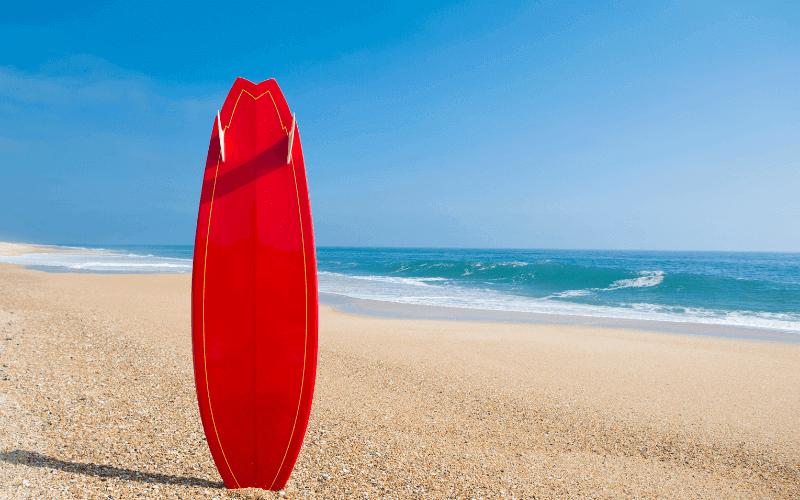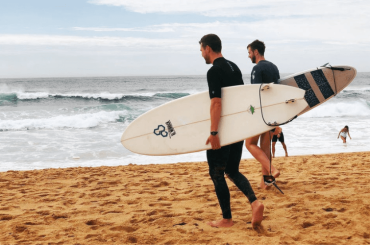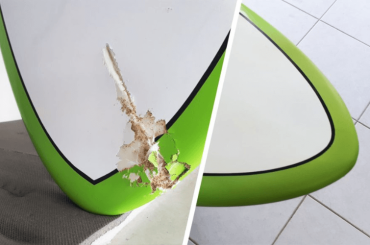If you are a surfer then you know that one of the biggest dangers is being caught out in the water with a waterlogged surfboard. Too heavy a board can make it difficult to paddle and keep control of your board.
In this blog post, we will discuss some ways to tell if your surfboard is waterlogged and how to fix the issue.
How to tell if a surfboard is waterlogged?
Waterlogging is when a surfboard absorbs water, which makes the board heavier and more difficult to control.
Waterlogging can happen for several reasons, but one of the most common is leaving your surfboard in the sun for too long.
There are a few ways that you can tell if your surfboard is waterlogged.
- One way is to pick up your board and see how heavy it feels. A waterlogged board will be significantly heavier than a board that is not waterlogged.
- Another way to tell if your surfboard is waterlogged is to look at the bottom of the board. If there are any large bubbles or indentations, this is a sign that the board has absorbed water and is now waterlogged.
- The board may also have water dripping from it, or there may be water inside the board (you can check this by looking for water bubbles under the wax).
If your surfboard is waterlogged, it’s important to dry it out as soon as possible to prevent further damage.
How to fix a waterlogged surfboard?
If your surfboard is already waterlogged, the best thing to do is to dry it out on time. This can be done by laying the board in the sun or dry place.
You can also use a hairdryer on a low setting to help speed up the drying process. Once the board is dry, you’ll need to apply a new layer of wax to help create a barrier against future water damage.
How to prevent waterlogging on surfboards?
To prevent waterlogging, it’s important to keep your surfboard out of the sun when you’re not using it.
- If you’re going to be in the sun for a long period, it’s also a good idea to cover your surfboard with a towel or t-shirt to protect it from the sun’s rays.
- Another way to prevent waterlogging is to wax your surfboard regularly. Waxing helps create a barrier between the board and the water, which can help prevent the board from absorbing water.
- You can also try using a waterproofing spray or sealant on your surfboard to help prevent water damage in the future.
Some consequences of having a waterlogged surfboard?
If you don’t take care of a waterlogged surfboard, it can cause the board to break down and become structurally unsound.
This means that it could break in half while you’re surfing, which could be dangerous.
Waterlogging can also cause the glue that holds your surfboard together to break down, which can weaken the board’s overall structure.
FAQs – Waterlogged Surfboard
How do I know if my surfboard is watertight?
The best way to test if your surfboard is watertight is to place it in a bathtub or bucket of water. If the board leaks, then it is not watertight and will need to be repaired.
Another way to do this is to hold the board up to your ear and listen for any dripping sounds. If you hear any, that means there’s a hole in your board that needs to be fixed before you go surfing.
Do Foamies get logged?
Foam surfboards do not get logged. However, if you are surfing in an area with a lot of waves, it is always best to wear a life jacket and leashes for safety.
What does water damage on a surfboard look like?
Water damage on a surfboard will appear as either stains or bubbles on the surface of the board. If the damage is severe then board may start to delaminate which means the layers of the board will start to separate.
How long does it take to dry out a waterlogged surfboard?
This is a difficult question to answer since it can depend on several factors, such as the size and thickness of the board, temperature, humidity of the environment and how much water was absorbed by the board.
However, it could take anywhere from a few days to a couple of weeks for a surfboard to fully dry out. If possible, it’s best to store the board in a warm, dry place during this period to speed up the drying process.
Do surfboards lose buoyancy?
Most surfboards are made with materials that won’t lose buoyancy over time. However, if your surfboard starts to lose buoyancy, it is likely due to water damage or a waterlogged board. In either case, the board will need to be repaired or replaced.
Final Verdict
If you’re ever in doubt about whether your surfboard is waterlogged, there are a few things you can do to check.
- One simple test is to take the board out into the waves and see if it floats. If it doesn’t, that’s a good indication that it’s waterlogged.
- You can also perform a weight test by putting the board on a scale and comparing its weight to when it’s dry.
- Finally, you can use your hands to feel for any excess moisture inside the board. If you find any, then your board is likely waterlogged.





